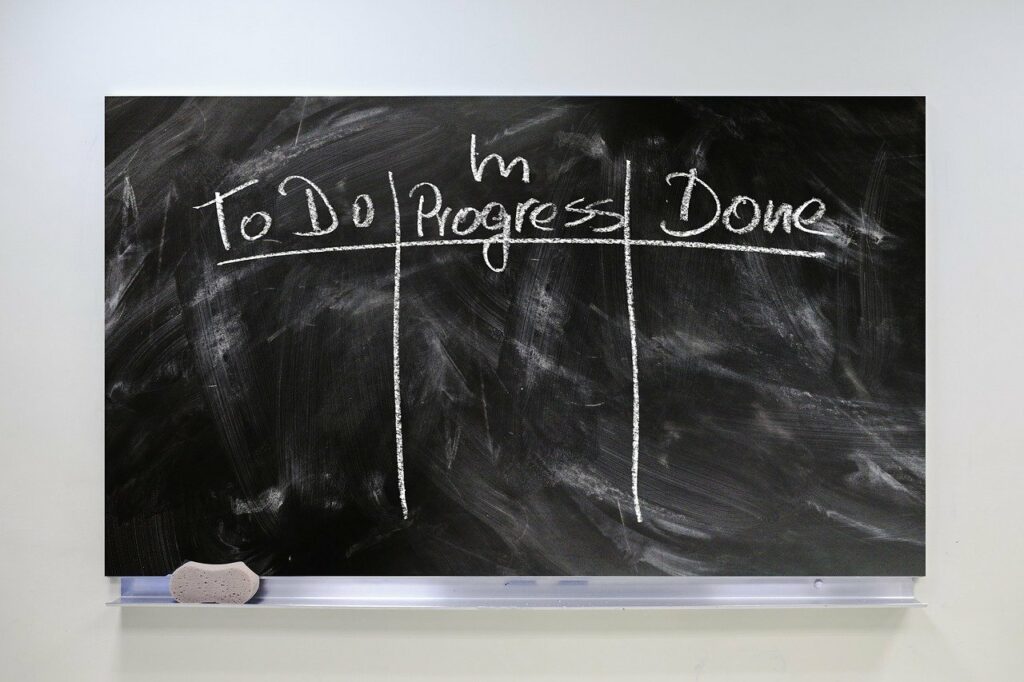
Project Management Boards have become essential tools for organising tasks, collaborating with team members, and tracking progress on projects. Especially with the increase in remote working, and working from home.
There are numerous options available, and selecting the right project board for you / your organisation can significantly impact the efficiency and success of your team’s workflow. In this blog, I’ll explore some of the best project boards to consider based on their features, user-friendliness, and suitability for different organisations, ways of working and types of projects.
One feature many of these tools offer is what is referred to as a Kanban board. So …

A Kanban Board is a visual display tool that gives an overview of the current work/project status and simplifies team communication. Visualising work on a Kanban Board can boost productivity and eliminate chaos.
Kanban boards’ history starts way back in the 1960’s in the Toyota Motor Company in Japan. Around 2006, as the Kanban method was gaining popularity, software developers started to apply it to the common practice of visualising and sharing project status by posting cards on whiteboards in the project room. Application of Kanban principles to the otherwise chaotic project boards gave them the columns and structure from which modern Kanban boards have emerged. Now they can be successfully used in all kinds of industries and everywhere where visibility of work status helps to organise work better.
Here is my list of popular project management platforms, each with their own set of advantages and disadvantages.
1. Trello: Trello is a popular choice for its simplicity and flexibility. Its intuitive interface uses Kanban boards, lists, and cards to represent tasks, making it easy for teams to visualise their workflow. Trello offers features like customisable cards, checklists, labels, and due dates, making it suitable for various project management needs. It’s ideal for smaller teams and projects that require quick setup and minimal learning curve.
2. ClickUp: ClickUp stands out for its customisable interface, offering a wide range of features suitable for various project management needs. Its versatility allows teams to adapt workflows to their preferences, enhancing productivity. However, its complexity might overwhelm some users, especially if you are looking for a simpler solution.
3. Monday.com: Monday.com provides a visually appealing and customisable platform for project management. Its flexible structure allows teams to create custom workflows, automate repetitive tasks, and collaborate in real-time. Monday.com offers various templates for different project types, making it suitable for teams across different industries and departments. It’s particularly useful for teams looking for a modern and customisable project management solution.
4. HubSpot: HubSpot integrates project management with marketing and sales tools seamlessly, offering a unified platform for businesses. Its intuitive interface and robust reporting capabilities make it attractive for marketing-centric teams. Yet, its pricing might be a deterrent for smaller businesses.
5. Zoho Projects: Zoho Projects provides a comprehensive suite of tools suitable for teams of all sizes, with features like task management, time tracking, and collaboration tools. Its user-friendly interface and affordable pricing make it appealing for small to medium-sized businesses. However, some users may find its customization options limited compared to other platforms.
6. Asana: Asana is known for its robust features designed to handle complex projects and larger teams. It offers customisable project views, task dependencies, timelines, and advanced reporting capabilities. Asana’s interface is highly organised, allowing teams to break down projects into manageable tasks and track progress effectively. It’s suitable for teams that require detailed project planning and coordination across multiple departments or stakeholders.
7. Microsoft Planner: Microsoft Planner, is great for integration with other Microsoft Office applications like Teams and Outlook facilitates seamless collaboration and communication among team members. Its user-friendly interface and simple drag-and-drop functionality make it easy to use for team members at all levels of technical proficiency. However, while Microsoft Planner offers a straightforward and accessible solution for basic project management needs, it may not be suitable for more complex projects requiring advanced features and customisation options.
8. Jira: Jira is a powerful project management tool widely used in software development and IT industries. It offers extensive customisation options, agile project management features, and integration with development tools like Git and Jenkins. Jira’s issue tracking, scrum boards, and Kanban boards make it suitable for teams practicing agile methodologies. However, its complexity may require some learning curve, making it more suitable for experienced teams and larger projects, most likely corporates.
I have just chosen a few of the many options on the market.
Ultimately, the choice between these platforms depends on the specific needs and preferences of each team or organisation. To help you make a decision, here are some questions to ask yourself ….
How easy is it to use?
How steep is the learning curve? (Do I need to be techy?)
Will my data be safe? When deciding which to go with look at what the providers have in place regarding security.
How much does it cost? This will depend in part on the number of people you want to use it, and what features you want to have. Most of the tools will have different plans on offer. So it is worth working out what you really need, especially if you are paying for it. Some have a free option, which might be worth signing-up for and using to see how you get on. Most paid providers offer a free trial e.g. 7 – 14 days, so you can try before you buy.
If you and your team haven’t used Project Management board tools before, why not have a look at the free tools, and try out different options, to see for yourself.
Fortunately, there are lots of free options available that provide robust features without breaking the bank. I am listing a few of them below that are worth exploring:
1. Trello
2. Asana
3. Jira Software
4. ClickUp
5. MeisterTask
6. Monday.com
7. Zoho Projects
8. Todoist
When choosing a project management board for your team, also consider factors such as the size and complexity of your projects, the number of team members, preferred project management methodologies, and integration requirements with other tools your team uses.
By selecting the right project board, that aligns with your team’s needs and preferences, you can streamline your workflow, improve collaboration, and ultimately achieve greater project success.
Whether you’re managing a small team or coordinating complex projects, the free project management board tools mentioned in this post offer valuable features to help you stay organised, collaborate effectively, and achieve your goals. I recommend you experiment with different tools to find the one that best fits your team’s needs, and so you can harness the power of technology to drive your projects forward.
If you would like help choosing which tool might be right for you and your business, or help setting-up a Project Management Board, I’d be delighted to help. Please get in touch and we can discuss your requirements.